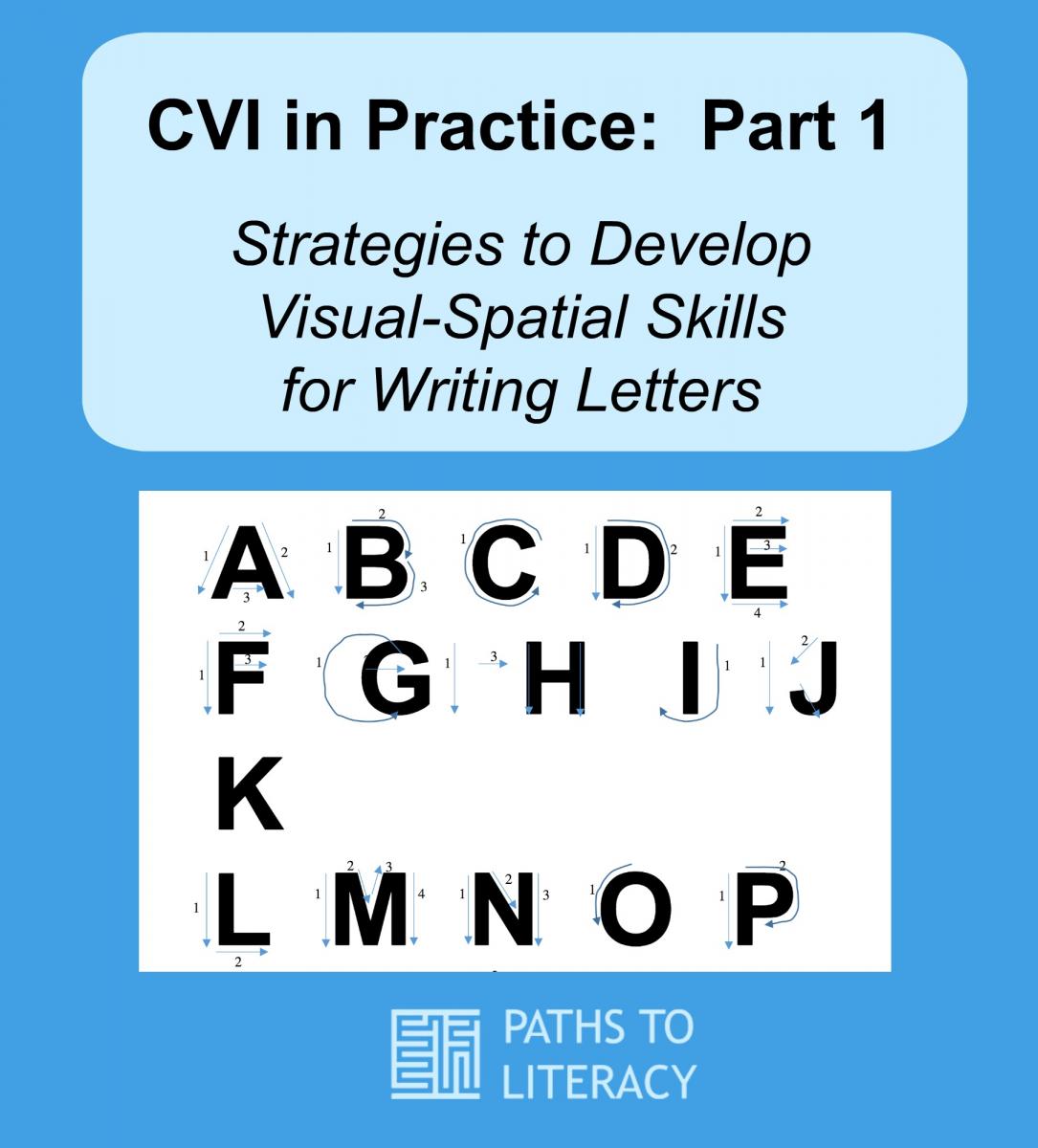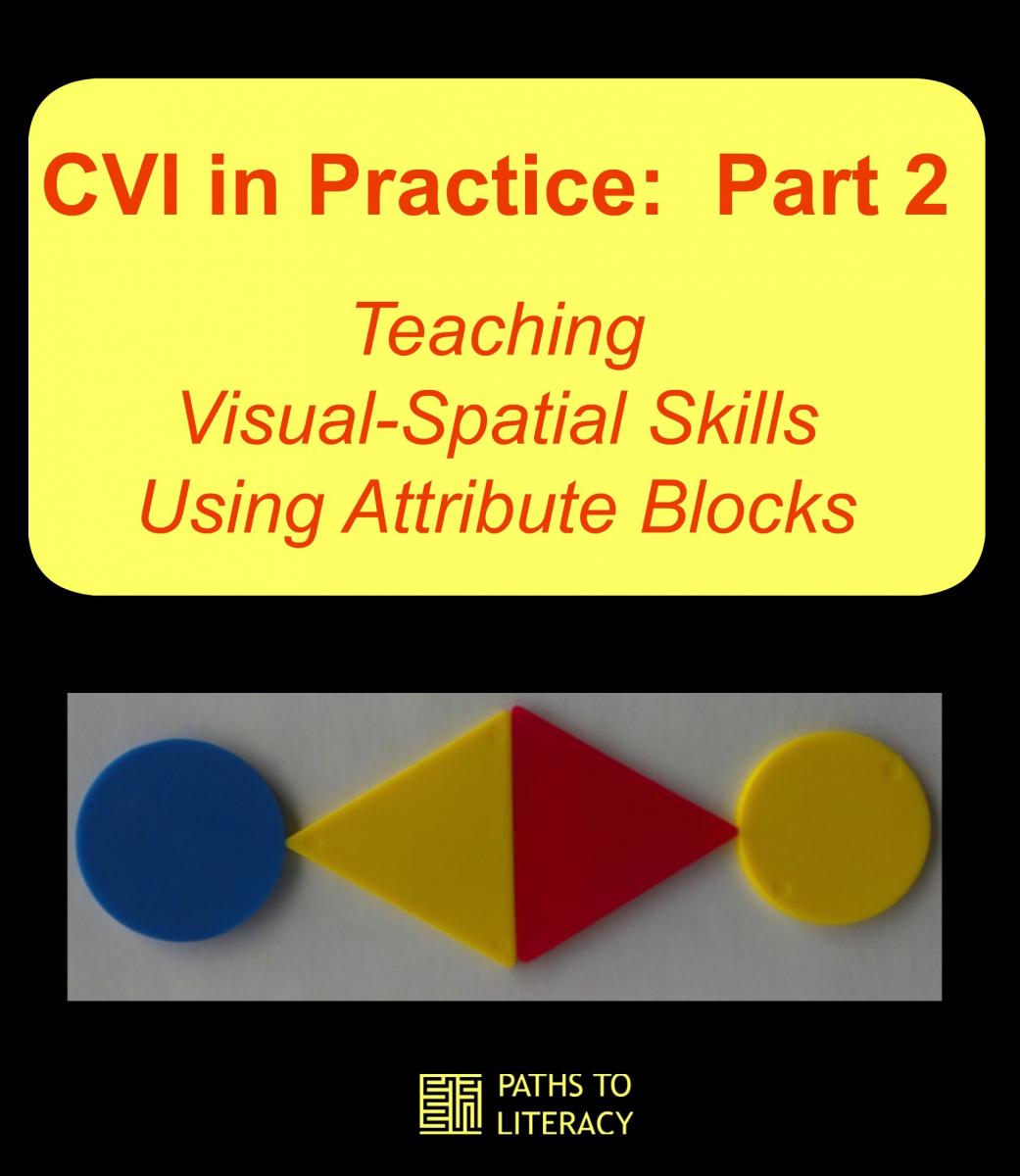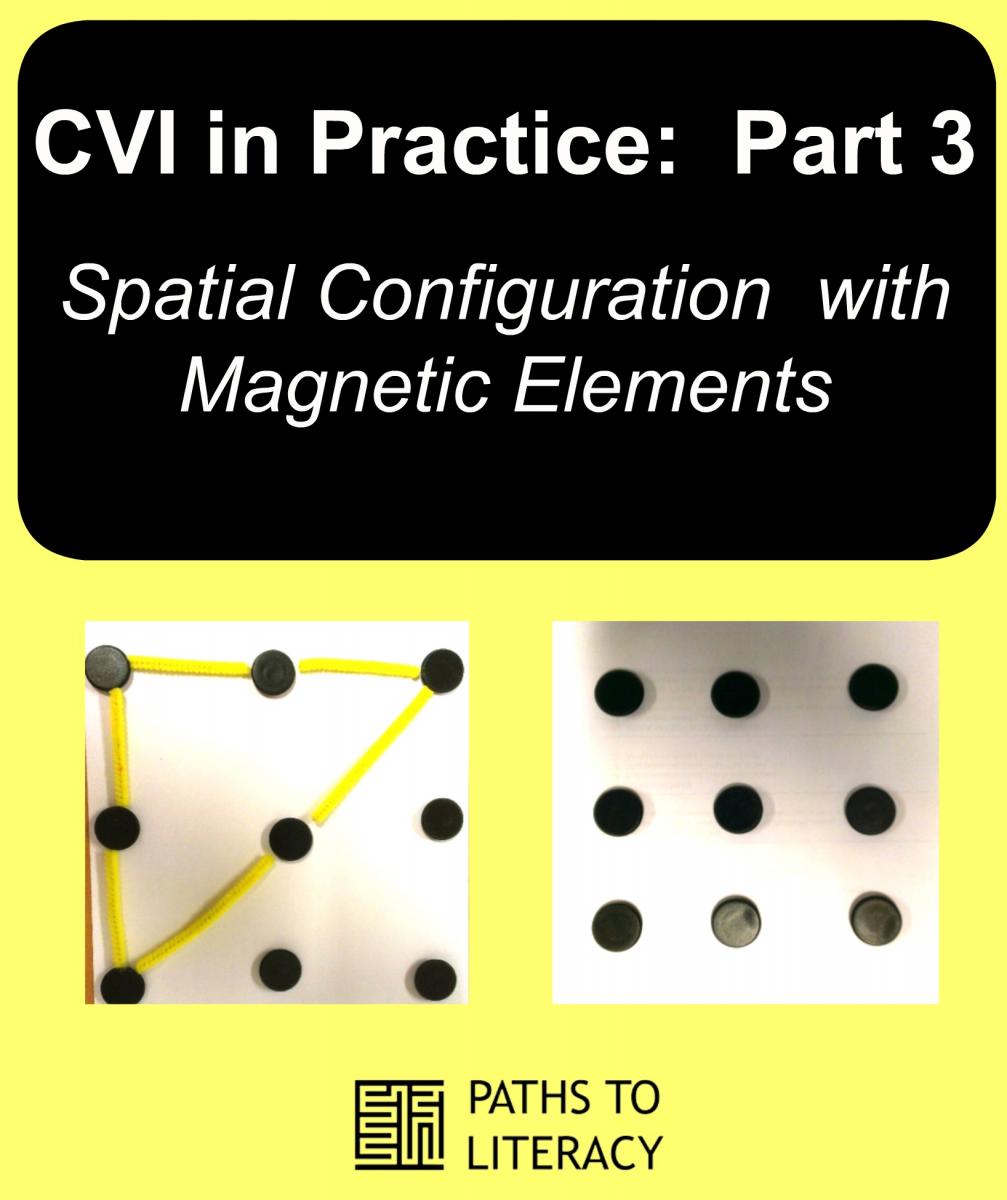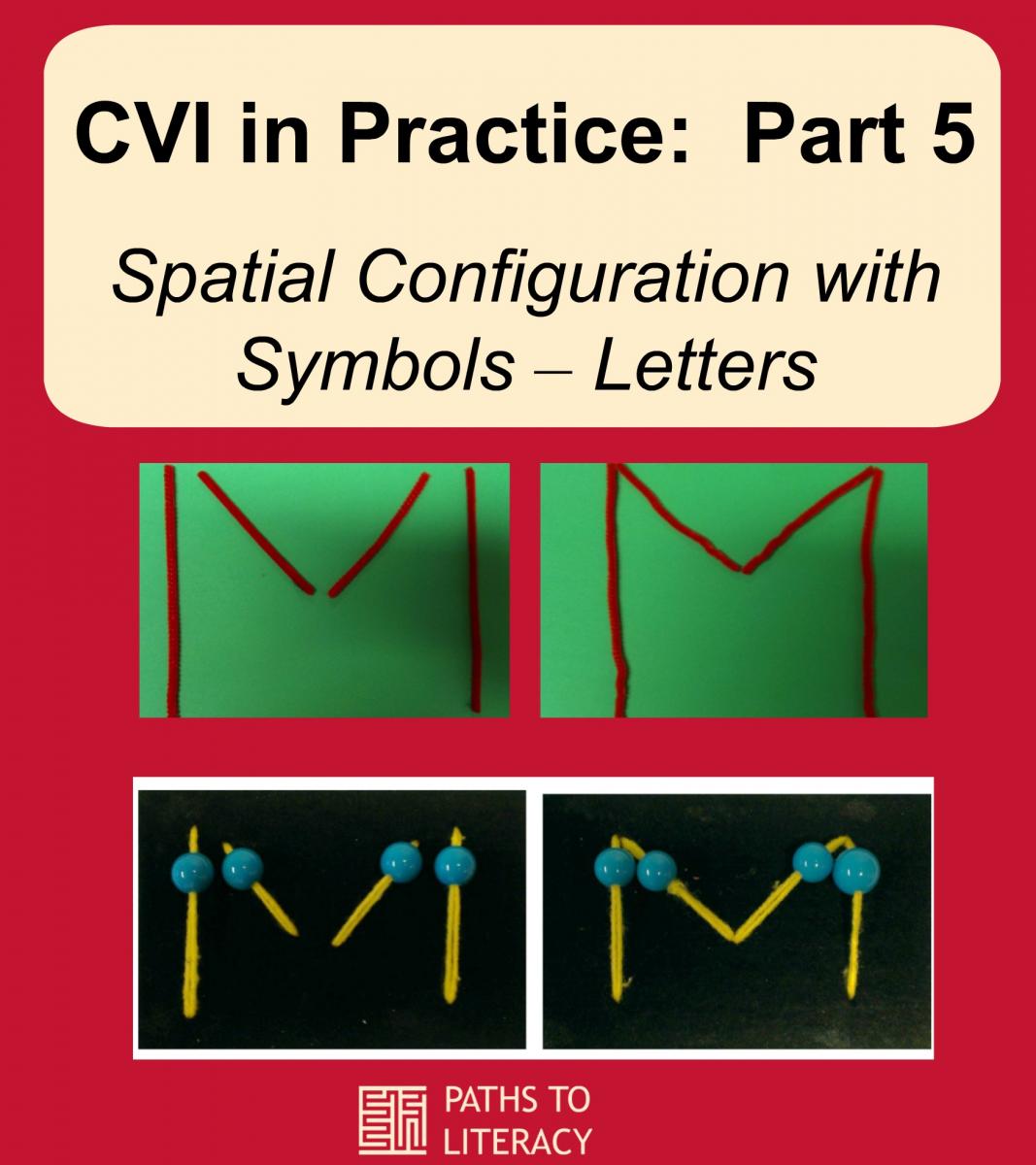CVI in Practice: Strategies to Develop Visual-Spatial Skills for Writing Letters
Submitted by Roxana Cziker on Oct 24, 2016
This is the first of five parts created by Low Vision Therapist, Dr. Roxana Elena Cziker, focusing on the needs of students with Cerebral Visual Impairment (CVI) The series is designed to address challenges for children with CVI who have difficulties with visual-spatial relations, specifically in understanding the composition of spatial configurations and the relationship between the component elements of the configuration and difficulties in writing.
The Challenge for Children with Cerebral Visual Impairment

The difficulties in visual perception such as visual-spatial relations, closure, figure-ground perception, perception of details, etc. may be reflected in the graphic activity of children in educational tasks, such as writing. Sometimes children do not see the relationships among the component elements of a letter, and may see them more like drawings, rather than as a symbol or a “paint the letter” in a notebook. The pattern – the letter – is perceived as a whole, not necessary with a particular meaning. For some children it may be difficult to separate out the different parts.
The information is perceived as a group of elements, and it may be difficult to separate them into individual parts. At the brain level, the elements are difficult to separate and then put together, as representations. Each element exists in the memory, but it may be difficult to sort out each part of it and then put it all together and interpret the whole symbol as a letter.
On the other hand, some children are missing the strategy of visual searching and exploration of separate elements of a letter and instead they put together entire elements. They do not know where to start looking, how to analyze, or how to look at an image or a symbol / letter. The next stage of putting together the letters in a word, and giving meaning to a particular word often becomes a more complicated task.
The Need for Specific Educational Strategies
In this situation, children need specific educational strategies to enable them to learn an organized manner of visual searching, in which they point out visually or through movement (by hand) each element, and name each perceived element. They then have to be able to establish the order of each element in a pattern and to identify the relationship among the component elements in order to create an entire image or letter. Thus, the children will be able to represent, at the mental level, not only individual objects or elements, but also groups of elements in order to create patterns, scenes, etc.
This resource was especially designed for children with cerebral visual impairment and particularly for children with difficulties in visual spatial relations, understanding the composition of spatial configurations and the relationship between the component elements, as well as difficulties in writing.
Prerequisites Necessary for Writing Letters
Visual Function |
Description |
|
1. Visual Fixation |
Maintaining a single gaze and holding an object, a single target, or a location steadily in view. This visual function is necessary to fixate elements on a page and also in a particular position, finding details in an image or in different subjects, such as mathematics, biology and geography. The oculomotor functions in general are important for paying attention, copying from the blackboard or book, reading efficiently and doing well in sports (2, 6, 8). |
|
2. Saccades
|
Rapid eye movement which is usually conjugate (both eyes more together in the same direction), under voluntary control. They range in amplitude from the small movements made while reading, for example, to the much larger movements made while looking around a room. Saccades can be elicited voluntarily, but occur reflexively whenever the eyes are open, even when fixated on a target. These movements are necessary in bringing the images of a particular area of the visual world to fall onto the fovea. Contributes to reading fluency and looking at a picture in a book (4, 5).
|
|
3. Visual attention
|
Ability to focus on specific elements in the visual scene, as related to visual processing. Necessary to identify objects, images, symbols in patterned or visually cluttered scenes.
|
|
4. Visual acuity
|
Individual´s capacity to detect small spatial gaps in a figure, e.g. circle or square of maximum contrast (black and white) or between two parts of a figure to discriminate and identify single forms, letters or numbers or to process text materials (reading acuity). It is influenced by the eye movements (saccades, fixation, etc.) and memory. It is necessary for seeing both distance and near objects and visual scenes.
|
| 5. Visual field | Totality of the visual space that can be perceived by an eye with no vision deficiency. It is necessary for scanning a small space, for visually searching and scanning the entire page, spatial localization of objects and images, judging an object´s position, etc. (6). |
|
6. Visual strategy and searching
|
Ability to find, in an organized manner, a single definite target among distractors. Visual exploration of a scene or searching for targets, depending what the task is. It is necessary in reading and writing, image matching, finding the school in the neighborhood, orientation in a group of people, finding your favorite candy in a box, etc. (1,6). |
|
7. Visual discrimination
|
The ability to differentiate between objects and forms, and to visually detect differences in variables such as shape, pattern, color, size. It is very much related to shifting gaze from one image to another in order to be able to compare images within the visual field and scanning. It is necessary to distinguish between different letters, such as b and d, p and q, etc. There may be difficulty learning the alphabet and recognizing letters and words; confusion of similar shapes, letters, numbers; mistaking words with similar beginnings or endings; trouble writing and remembering letters (1, 3). |
|
8. Visual-ground discrimination
|
Ability to visually locate and identify shapes or objects embedded in a busy visual background, as well as differentiating between relevant and irrelevant information in the environment. The difficulty arises in being able to block distractors, such as conflicting words or images around the classroom. It may be helpful to increase the time to do classroom tasks, such as copying from the blackboard or finding a certain color pencil (1, 3). |
|
9. Visual memory
|
Ability to remember visual details of what has been seen, as well as the capacity to remember visual experiences. It is necessary to remember and retrieve the letter in order to identify, recognize and put it together in a word. |
|
10. Eye-hand coordination
|
Ability of the visual system to coordinate information received from the eyes to control, guide and direct the hands to accomplish a given task, such as handwriting or catching a ball (1). |
|
11. Visual-spatial relations
|
The ability to process the spatial properties of optical stimuli, including position, distance, depth, and direction (horizontal, vertical and straight ahead) in both 3-dimensions and 2-dimensions. |
|
12. Visual sequencing
|
Establish the order of symbols, words or images. If there is an issue with this ability, the child may skip lines when reading. Sequencing is a specific difficulty for dyslexic learners. Sequencing difficulties can affect visual processing, which causes confusion among similar words (of/for, saw/was, etc.). It also affects auditory processing, with sounds being mis-sequenced. It can also affect sentence construction and planning skills for essays and other written work. The child with a difficulty in this area is often unable to perceive the order of stimuli in which they appear. For example, the child may have difficulty arranging pictures of events in the sequence in which they are presented, in copying the alphabet or numbers in the correct order, or in seeing the order of letters in words (9). |
References:
- Ekkens I.E. (2001). Manual and justification for the IN-Sight tool for visual perception in children with vision impairment.
- Kosnik W., Fikre J. and Sekulert R. Visual fixation stability in older adults. No.12 pp. 1720 – 1725.
- Kurtz L.A. (2006). Visual perception problems in children with AHDH, autism and other learning disabilities: a guide for parents and professionals. London: Jessica Kinghsley Publisher.
- Merriam-Webster Dictionary. (http://www.merriam-webster.com/dictionary/saccades)
- Purves D., Augustine G. J.Fitzpatrick D., Katz L. C. et al. (2011). Neuroscienece second edition. Type of the eye movements and their function. ISBN – 10: 0-87893-742-0.
- Zihl J. and Dutton G. N. (2015). Cerebral visual impairment in children. Springer. ISBN – 978-3-7091-1814-6.
- Zihl J. (2011). Rehabilitation of cerebral visual disorders, 2nd edt. Psychology Press.
- Willings C. Teaching students with visual impairments. Oculomotor skills. (http://www.teachingvisuallyimpaired.com/).
- What is Visual Sequencing? http://www.edublox.com/visual-sequencing.htm






Comments
CVI and letter writing
CVI
Teens with CVI
My child